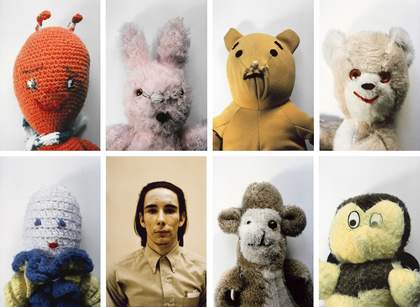
Mike Kelley Ahh...Youth! 1991/2008 © Mike Kelley Foundation for the Arts. All Rights Reserved / VAGA at ARS, NY & DACS, London.
This week, Tate Modern opens the first major UK survey exhibition of American artist Mike Kelley (1954–2012). Kelley’s influential and experimental practice ranged from drawings and collages to videos, performances, and multimedia installations to create a kind of “dark pop art”. Drawing upon the media, popular and underground culture, philosophy, literature, and historical material, his radical works question the systems of belief and institutional structures that shape our societal roles. Spanning Kelley’s entire career, the exhibition marks a rare opportunity for new audiences to discover the elaborate, provocative, and imaginative worlds he created, which continue to resonate over a decade after his passing.
The exhibition revolves around a script for an unrealised performance by Kelley titled Under a Sheet/Existance Problems [sic] held in the artist’s archive. The script explores the idea of the ghost which disappears whilst the spirit lingers. These ideas point to Kelley's lifelong exploration of absence, ritual and identity, heavily influenced by his Catholic upbringing. Opening with Kelley's early performances created while studying at California Institute of the Arts (CalArts) in 1976–8, the exhibition features one of his most significant and unnerving works, The Poltergeist 1979. Created as part of a collaborative exhibition with artist David Askevold, this 7-part photographic work depicts Kelley exuding a mysterious ethereal substance from his nostrils, mimicking the look of period spiritualist photography from the early 20th century.
The exhibition includes works from Kelley's dynamic early installations, such as the Monkey Island project 1982–3, and the expansive project Half a Man 1987–91, which introduces his work with craft objects. The artist viewed craft as an act of resistance against the dominance of modernist painting and sculpture, which he considered inherently masculine. Instead, Kelley chose to create sculptures using familiar objects such as handmade stuffed toys and crocheted afghans, seeking to capture feelings of the uncanny in the everyday. Worn and often grubby second-hand toys are worked into colourful and playful arrangements such as More Love Hours Than Can Ever Be Repaid and The Wages of Sin 1987 and his Ahh...Youth! photographs 1991, best known from the cover of Sonic Youth's album ‘Dirty’. These works, and Kelley’s later use of audio tapes with spoken texts for his Dialogues series, undermine the first impression of innocent children’s toys, evoking thoughts about gender and familial power structures as well as an underlying sense of the sinister.
In the mid-1990s Kelley decided to build on the public fascination with the confessional narrative, and how this relates to various forms of belief systems including conspiracy theories. Central to this exploration was the role of memory in how we construct and understand the world around us. A slideshow of images represent the major work Educational Complex 1995, a large sculptural model of every place that Kelley had been educated. The influence of this monumental project is explored through the associated works Sublevel 1998, based upon the basement of CalArts, where he had studied in the 1970s and Relationships Rendered as Fluid 2002 - two hanging mobiles and their associated drawings, which play on the relationship of architectural space to memory.
The exhibition culminates with Kelley’s later installations that continued his exploration of the role of memory and repressed desire. They include works from Kelley’s epic multi-part project Extracurricular Activity Projective Reconstructions 2000–2011, which involved him restaging photographs of extra-curricular activities featured in high school yearbooks as musical and theatrical video and sculptural installations. Kelley viewed these activities as a means for people to play out fantasies and escape normal life. Six of these installations will be shown alongside the original photographs that inspired them. A major highlight of the exhibition is Kelley’s major Kandors series 1999–2011. These illuminated models of Superman's mythical lost home, each preserved in a glass bell jar, form a ghostly cityscape that hints at the psychological depths of this iconic American superhero.
